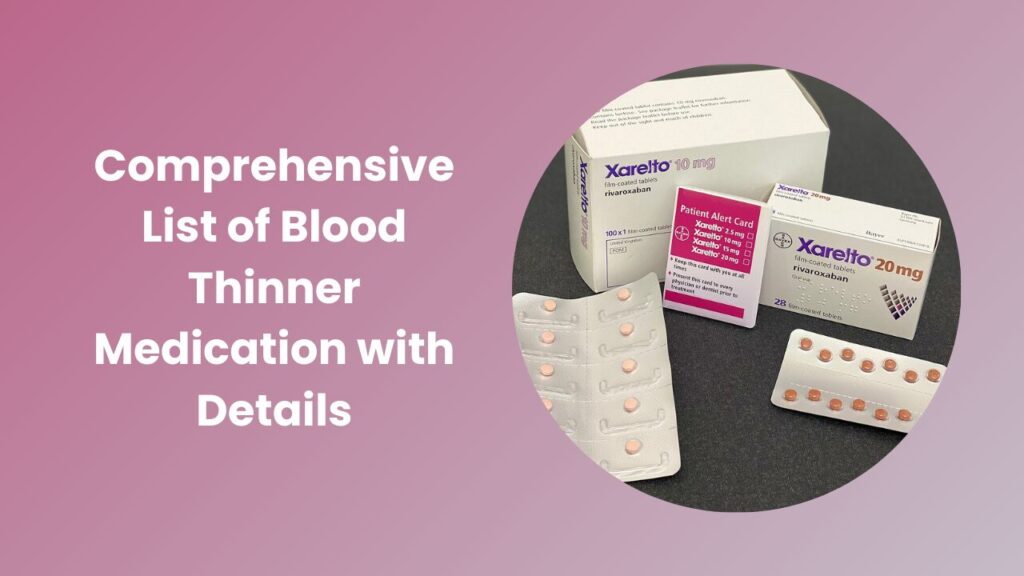Blood thinners, also called anticoagulants or antiplatelet drugs, are essential medications used to prevent life-threatening blood clots, strokes, and heart attacks. They work by reducing the blood’s ability to clot, allowing blood to flow more freely through veins and arteries. Doctors commonly prescribe these medicines to patients with conditions such as atrial fibrillation, deep vein thrombosis, pulmonary embolism, or after major surgeries. Understanding the list of blood thinner medication available today is important because each drug has its own purpose, benefits, and possible side effects.
What Are Blood Thinners?
Blood thinners are not designed to actually “thin” the blood but rather to prevent it from forming clots too easily. When a clot blocks a blood vessel, it can cause severe complications like stroke or heart attack. These medications are divided into two main categories: anticoagulants, which slow down the clotting process, and antiplatelets, which prevent blood cells from sticking together. Both groups play a vital role in protecting patients who are at risk of clot-related health issues.
Importance of Knowing Different Blood Thinners
Choosing the right blood thinner depends on a patient’s medical history, condition, and risk factors. Some drugs are prescribed short-term after surgery, while others are taken for life. Having a clear idea of the blood thinner medication helps patients better understand their treatment, follow doctor’s instructions carefully, and recognize potential side effects early.
List of Blood Thinner Medication
Warfarin (Coumadin)
Warfarin is one of the oldest and most widely used blood thinners. It works by blocking vitamin K’s role in clot formation, which slows the clotting process. Patients taking warfarin need regular blood tests, known as INR tests, to ensure the medication is working effectively without causing excessive bleeding. Dietary habits, especially foods rich in vitamin K like spinach and kale, can interfere with its effectiveness. Warfarin remains a trusted option, especially for people with heart valve replacements or chronic clotting disorders, though its monitoring requirements can be challenging.
Heparin
Heparin is a fast-acting anticoagulant often given in hospitals through injections or intravenous infusions. It prevents clots from forming or growing larger by enhancing the activity of antithrombin, a natural clot-preventing protein in the body. Since heparin acts quickly, it is commonly used after surgeries, during dialysis, or in emergency situations. However, its short duration means it is not usually prescribed for long-term use. Doctors carefully adjust the dosage based on frequent blood tests to avoid complications like excessive bleeding or low platelet counts.
Enoxaparin (Lovenox)
Enoxaparin belongs to the class of low molecular weight heparins. It is usually injected under the skin and is often prescribed for patients recovering from surgery or those at risk of deep vein thrombosis and pulmonary embolism. Compared to regular heparin, enoxaparin requires less frequent monitoring, making it easier for patients to use outside the hospital. Its predictable action and convenience make it a common choice, though it can still cause side effects like bruising, bleeding, or injection site discomfort.
Rivaroxaban (Xarelto)
Rivaroxaban is part of a newer group of anticoagulants known as direct oral anticoagulants (DOACs). It works by directly blocking Factor Xa, an essential protein in the clotting process. Rivaroxaban does not require routine blood testing, making it more convenient than traditional options like warfarin. Doctors often prescribe it to prevent strokes in people with atrial fibrillation or to treat conditions like deep vein thrombosis. Although easier to manage, rivaroxaban still carries risks such as bleeding, and patients must follow dosing schedules strictly to maintain effectiveness.
Apixaban (Eliquis)
Apixaban is another widely prescribed DOAC that inhibits Factor Xa. It is taken orally and is known for having fewer side effects compared to older blood thinners. Apixaban reduces the risk of stroke in patients with atrial fibrillation and also helps prevent clot formation after hip or knee replacement surgeries. Unlike warfarin, it does not require strict dietary monitoring or frequent blood tests, making it a patient-friendly option. Still, like all anticoagulants, it increases the risk of bleeding, especially if combined with other medications like aspirin.
Dabigatran (Pradaxa)
Dabigatran belongs to the class of direct thrombin inhibitors. It prevents clot formation by directly blocking thrombin, the enzyme responsible for converting fibrinogen into fibrin, which forms clots. This medication is taken orally and is commonly used to reduce the risk of stroke in people with atrial fibrillation. One advantage of dabigatran is that it has an antidote available in case of severe bleeding, which is not true for all blood thinners. Patients taking dabigatran should still be aware of possible side effects such as stomach upset or bleeding complications.
Edoxaban (Savaysa)
Edoxaban is another oral anticoagulant that works by blocking Factor Xa. It is used to prevent strokes and blood clots in patients with atrial fibrillation and to treat deep vein thrombosis and pulmonary embolism. Edoxaban is appreciated for its once-daily dosing, which simplifies treatment plans. While it reduces the need for regular blood testing, it still carries risks such as bleeding or reduced effectiveness in patients with very good kidney function. Doctors usually weigh these factors carefully before prescribing it.
Aspirin
Aspirin is a well-known antiplatelet drug rather than an anticoagulant. It works by preventing platelets from clumping together, reducing the chance of clot formation. Low-dose aspirin is commonly prescribed to patients with a history of heart attacks, strokes, or cardiovascular disease. Although available over the counter, aspirin should only be used regularly under medical advice because it can increase the risk of stomach ulcers and bleeding. Despite its simplicity, aspirin remains an important part of the blood thinner medications due to its role in cardiovascular protection.
Clopidogrel (Plavix)
Clopidogrel is another powerful antiplatelet medication. It is often prescribed to patients who have had stents placed in their arteries or those recovering from a heart attack. By preventing platelets from sticking together, it reduces the risk of clots forming inside stents or damaged blood vessels. Clopidogrel is usually taken daily, and while effective, it may cause side effects like easy bruising or stomach irritation. Some patients may also have genetic differences that make the drug less effective, so doctors sometimes recommend genetic testing before prescribing it.
Ticagrelor (Brilinta)
Ticagrelor is a modern antiplatelet medication used to reduce the risk of cardiovascular events in patients with acute coronary syndrome. Unlike clopidogrel, it works faster and does not rely on liver enzymes to become active, making it more predictable. Ticagrelor is taken orally but often in combination with low-dose aspirin for maximum effectiveness. Although beneficial for high-risk patients, ticagrelor may cause side effects such as shortness of breath or increased bleeding risk. Doctors usually balance these risks with the potential benefits before long-term use.
Risks and Considerations When Taking Blood Thinners
While blood thinners are life-saving medications, they come with certain risks. The most common concern is excessive bleeding, which may occur from minor cuts or internal injuries. Patients must inform healthcare providers about all medications and supplements they take to avoid harmful interactions. It is also important to follow the prescribed dose exactly, as skipping doses or overdosing can be dangerous. Regular medical checkups help ensure the medication is working safely and effectively
Conclusion
Blood thinners play a vital role in preventing strokes, heart attacks, and blood clots in at-risk patients. Understanding the list of blood thinner medication helps patients and caregivers make informed choices about treatment and follow safety guidelines closely. From traditional options like warfarin and heparin to modern DOACs such as apixaban and rivaroxaban, each drug has its own purpose and precautions. With medical supervision, blood thinners significantly improve quality of life and reduce life-threatening risks, making them an essential part of modern healthcare.
FAQs
What is the most commonly prescribed blood thinner?
Warfarin has been the most commonly prescribed for many years, but newer drugs like apixaban and rivaroxaban are now widely used due to fewer monitoring requirements.
Do all blood thinners require blood tests?
Not all. Warfarin requires frequent INR monitoring, while DOACs like apixaban, rivaroxaban, and dabigatran usually do not.
Can I take blood thinners with other medications?
You should always consult your doctor before combining blood thinners with other medicines, as some drugs and supplements may increase bleeding risks.
Are blood thinners safe for long-term use?
Yes, many patients use them long-term under medical supervision. The key is regular follow-up care to monitor safety and effectiveness.
Is aspirin considered a blood thinner?
Yes, aspirin is an antiplatelet drug that reduces clot formation and is often prescribed in low doses for heart health.





